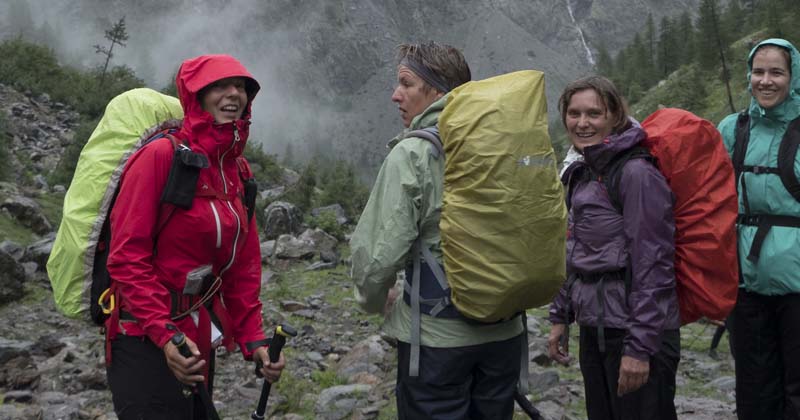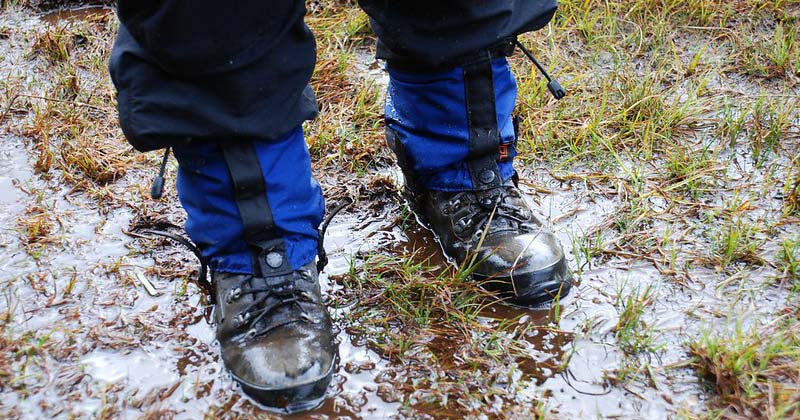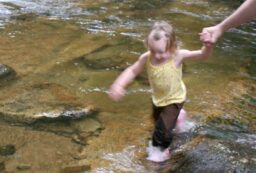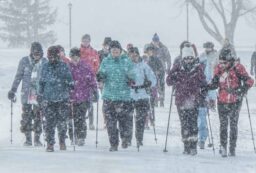A lot of hardcore hikers will brag about how they don’t let the weather get in the way of their plans. But hiking in the rain can be a miserable experience if you don’t manage to stay dry. It can also be downright dangerous since wetness may lead to hypothermia. So, follow these tips to stay dry while hiking in the rain.
1. Choose the Right Rain Jacket for Your Hike
This might seem like an obvious thing to wear in when hiking in the rain, but there are actually a lot of different types of rain jackets. Some are better suited for certain weather, types of hikes, or seasons.
Poncho
They might look like trash bags (and sometimes are made from trash bags), but a poncho will help keep you dry if an unexpected rain hits during your hike.
But there are many downsides of ponchos when hiking:
- Ponchos are very loose so have a tendency to funnel water all around.
- They flap around in windy weather.
- The cheap material can easily snag on branches.
- They can hinder your view of the ground.
Choose if: You are better off getting a proper rain jacket. Bring a poncho only if you have nothing else, it’s a day hike, and the forecast is good.
Rain Jackets
When we say “rain jacket”, we are usually referring to a one-layer jacket. It’s often made out of material like PVC which is completely waterproof. Rain jackets can also act as windbreakers.
The problem with rain jackets is that they aren’t breathable. You can end up sweating a lot in them, which makes you wet from the inside out. There’s also no insulation, so they won’t keep you warm if the weather gets cold.
Choose if: You are hiking in warm weather and you don’t want to carry a bulky rain jacket.
Soft-Shell Jacket
Soft-shell jackets are usually made out of several layers. The inner layers wick moisture away from your body and provide insulation. The outer layer has a water-resistant coating.
Soft-shell jackets give you the best of both worlds: They are breathable, stretchy, warm, and provide wind protection. The water-resistant coating keeps you dry when hiking in light rain. However, if there is a serious downpour, the rain will seep through the fabric. That’s the tradeoff between breathability and water-protection.
*Note that you should regularly reapply the water-resistant coating to your soft-shell jacket! Get a wash-in coating like Nikwax for jackets (get here).
Choose if: It’s cool outside and the weather probably won’t be too wet.
Hard-Shell Jacket
While a basic rain jacket is technically a type of hard-shell, we usually reserve the term “hard shell” for jackets that consist of multiple layers. The inner layers wick moisture away from your body and insulate you. The exterior layer is completely waterproof.
Because hard-shell jackets are completely waterproof, they are not breathable. There are some newer hardshells which claim to be breathable, though they tend to cost a fortune. The lack of breathability, in combination with the layers of insulation, mean that you will end up sweating like crazy. They are better suited for sitting around in cold weather and not hiking in the rain.
Choose if: It’s going to be very cold and very rainy on your hike.
2. Wear Rain Pants
It doesn’t make much sense to wear a rain jacket if you aren’t also going to wear rain pants. However, since our legs don’t require as much heat as our core, you don’t need the same amount of waterproofness as with your jacket.
If you are going hiking in warm weather and it’s not likely to rain much, then you are probably better off with water-resistant hiking pants. These are very breathable and dry quickly.
Completely waterproof pants become important when hiking in spring or fall, or during heavy rains. Depending on how cold it is likely to get, you can choose a pair of packable PVC rain pants to quickly put on over your normal hiking pants. Or you can get insulated waterproof pants to wear for the duration of the hike.
*Pay attentionto whether the pants say water-resistant or waterproof. REI has a good selection of waterproof hiking pants. Check them out here. Or see my picks for best waterproof hiking pants for women.
3. Invest in a Good Base Layer
A base layer is what’s worn directly against your skin. Its main job is to wick moisture away from your body.
Good base layers are especially important when hiking in the rain. Because your waterproof gear isn’t very breathable, you can end up sweating a lot. The wrong base layer will trap this sweat against your body, causing you to get wet from the inside instead of out.
Merino wool base layers are the most popular for hiking because of their breathability and warmth. Synthetics are a more affordable option but usually don’t feel as good against the skin. Read this post for more about base layers.
4. Don’t Forget a Hat with a Brim
A brimmed hat is especially important for hiking in the rain. It funnels rain in front of you so it doesn’t pool on your face and then run down your neck.
As someone who wears glasses, the brimmed hat is very important. Even if you don’t wear glasses, you’ll probably still want a brimmed hat for rain: it keeps the rain away from your eyes so you don’t end up squinting.
Lots of rain jackets have hoods with visors. These work to a point, but they don’t compare to the longer brim on a hat. Plus, the brimmed hat will keep sun out of your eyes too once the weather gets better.
5. Tuck In and Cinch Up Clothes
When the rain gets crazy, water can sneak in from all directions. It will roll down your hands and saturate your shirt sleeves. It will get absorbed by any layers peeking out of your shell. Heck, rain can even bounce up from the ground and soak you from under your rain jacket!
To keep dry, it’s important that you prevent rain from getting onto your clothing and saturating it.
Here are some tips:
- Tighten the wrist straps on your jacket. You want to keep the sleeves from riding up and getting your wrists wet, which will in turn get your base layers wet.
- Cinch your jacket’s drawstring. Good rain jackets have a drawstring or elastic at the bottom. This can be cinched to prevent your jacket from riding up and exposing your non-waterproof clothes.
- Tuck in your shirt. Even if you cinched your jacket drawstring, it may ride up while hiking. Minimize exposure risk by tucking in your shirt.
- Roll up sleeves and pant cuffs under your rain shell. This will create a “buffer zone” and keep your clothes from getting wet if your rain pants or rain jacket ride up.
- Shorten your hiking poles. You want your hands to be lower than your wrists so water doesn’t drip down your arms and soak your sleeves.
- Keep your arms down. Avoid the urge to put your thumbs in your backpack straps.
6. Keeping Feet Dry
When your feet get wet while hiking in the rain, the skin becomes more sensitive and prone to blisters and damage.
To keep your feet dry while hiking, you can:
- Waterproof your boots: The waterproof coating on boots will eventually wear away. Apply a waterproof wax or spray to your boots before each season.
- Use gaiters: Gaiters are covers that go over your lower legs and ankles. They keep rain from getting into your boots around the ankle area.
- Wear waterproof socks: Waterproof socks should be worn between your normal socks and boots. They act as a buffer to keep your feet dry even when your boots get wet. Randy Sun Gore-Tex socks are a great option for hiking.
The problem with these methods though is that your feet will probably get sweaty (and thus wet). A lot of serious hikers just give up on keeping their feet dry. Instead, they focus on minimizing the damage done by wet feet. More on that here.
7. Protecting Your Gear from Rain
You don’t want all the hiking and safety gear in your pack to get damaged by the rain. To keep it safe:
- Put a waterproof cover over your backpack: If your backpack didn’t come with a cover, there are universal ones you can buy.
- Use a dry bag: Water can still get into your pack even with a cover over it. Keep sensitive items like electronics safe by putting them in a dry bag.
- Put small items in Zip-lock bags: Especially make sure your map and first aid items are protected!
*The Unigear Dry Sack comes in various sizes and is completely waterproof.
8. Use Hiking Poles
Hiking poles don’t directly help you stay dry. However, trails get slick and muddy when it rains. Using hiking poles minimizes the risk that you’ll fall on your butt and splatter muddy water up your jacket. Plus, there’s tons of other reasons to use poles when hiking.
9. Bring a Sitting Pad
Time to take a break from hiking? When the weather is rainy, it’s not always easy to find a place to sit. The ground can be a giant mud puddle. Logs and rocks are cold and slippery. A simple solution is to bring a waterproof pad to sit on.
The Therm-a-Rest Z cushion is only 2 ounces and has an accordion-style fold so it’s easy to set up when you want to take a break. It’s waterproof so you don’t have to worry about it absorbing rain.
10. Pack Rain-Appropriate Food
One thing that people overlook when hiking in the rain is there food selection. Some foods – like sandwiches and tortillas – are terrible for rainy hikes. They get saturated and soggy when you try to eat them in the rain.
Choose foods which won’t get soggy quickly. Make sure that foods are in waterproof baggies. And, a hot meal goes a long way to keeping you warm in a cold downpour! Consider bringing a proper meal, like one of my DIY dehydrator recipes which can be made by just adding hot water.
Assume That It Will Rain on Your Hike
Remember, the weather can be very finicky – especially when you are hiking in the mountains or in shoulder seasons. Even if the forecast calls for good weather, pack as though it could rain.
In addition to bringing rain gear for your hike, be prepared for the worst. See this hiking packing list for all the gear you need to bring to stay safe.
Image credits:”Tour de l’Oisans et des Écrins (GR54)” (CC BY 2.0) by Kitty Terwolbeck
“Wet boots” (CC BY-NC-ND 2.0) by Kathrin Marks
Resources:
https://singletrackworld.com/forum/topic/opinion-soft-shell-or-hard-shell/
https://www.ukclimbing.com/forums/gear/is_the_traditional_hardshell_jacket_redundant-660502
https://backpackinglight.com/forums/topic/just-get-your-friggin-shoes-wet/
https://backpackinglight.com/forums/topic/106367/














Post your comments